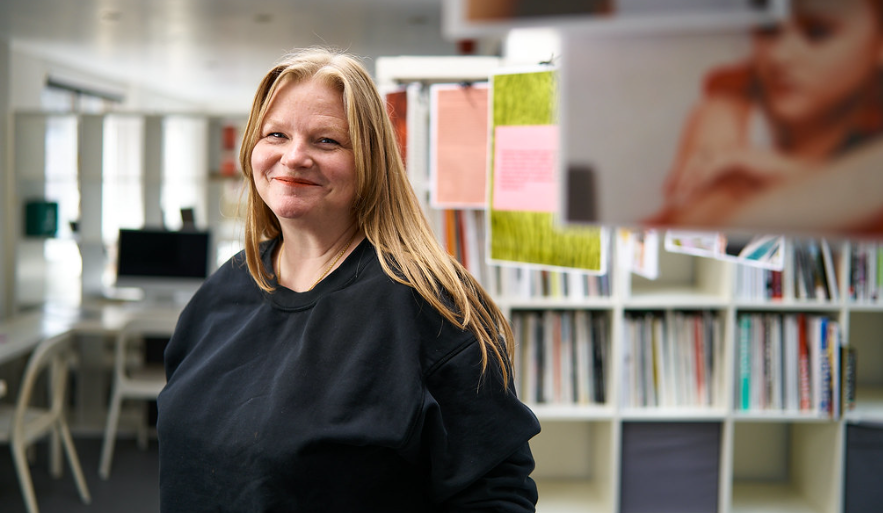In this interview, we meet Carolyn Timson, CSVPA’s senior lecturer in Fashion and Branding and accomplished fashion professional with over 25 years’ experience. As a renowned designer and creative adviser, Carolyn has played significant roles in prestigious brands like Moschino, Versace, and Maxmara, and until recently, was Vice President of Womenswear at Tommy Hilfiger. Her passion for empowering creatives and commitment to innovation and sustainability have made her a driving force in the fashion industry. Carolyn shares her experiences, innovations, and advice for the next generation of creatives.
Working with Iconic Brands
You’ve had the opportunity to work with some iconic fashion brands. Which ones did you enjoy working with the most, and what made those experiences special?
Each brand I worked with brought its unique challenges and rewards. However, the ones that truly stood out were the ones with a strong DNA. By this, I mean either a strong vision or significant visual identifiers. Brands like Versace or Tommy, with their distinct details, provided a platform to explore creativity while maintaining the brand’s essence or collaborations with celebrities with strong values, such as the entertainer Zendaya or Gigi Hadid, who used fashion to influence important changes.
Which brand do you most admire?
Do I have to pick one? This is so difficult! Ok, if I must, I’ve always admired Stella McCartney for her unwavering commitment to her brand’s ethos and innovative approach to sustainability and her strong stance against animal testing.
Empowering Creatives and Championing Sustainability
Your commitment to empowering creatives and sustainability has been a constant theme in your career. How have you championed these causes?
Sustainability has always been close to my heart. At Tommy Hilfiger, I was part of the team that spearheaded the use of organic cotton in 2005, recognising its potential impact on the industry and its suitability as an achievable goal for the brand with nearly every American wardrobe comprising cotton-based garments. Additionally, we used technology to revolutionise the process of getting the design in front of the customer more quickly using pioneering 3D imaging programmes, which reduced waste and streamlined production. Again, I was part of the original team that brokered conversations with DreamWork Studios (the makers of Shrek) to develop an imaging product suitable for the fashion industry. This product is now sold worldwide.
Nurturing talent has been an important part of my career and something I enjoy. I ran a consultancy at age 25, so I know first-hand the value of mentorship. At Tommy Hilfiger, I coordinated a scholarship programme in partnership with Kingston University, where I graduated, to provide aspiring students an opportunity to work with the brand. Many graduates went on to permanent positions across the group, but this injection of fresh ideas also invigorated the Tommy design team with new perspectives and energy.

“… The future of the fashion industry lies in small brands. They experiment with innovative ideas and take creative risks that larger, more established companies may find challenging due to their size and structure.”
Carolyn Timson
Senior Lecturer, Fashion & Branding, CSVPA
I’m also passionate about mentoring and supporting new brands. I’m currently working with a swimwear designer with a unique vision (Anouchka Houser). Her energy and passion are contagious. I believe the future of the fashion industry lies in small brands. They experiment with innovative ideas and take creative risks that larger, more established companies may find challenging due to their size and structure. Additionally, small brands have the potential to be more authentic and purpose-driven. They seem to be better at engaging directly with their audience, fostering a sense of community and thus building loyal relationships.
Balancing Creativity with Commerciality
Finding a balance between creativity and commerciality can be challenging. How do you approach this balance in your work?
For me, it’s about finding creative solutions and being a bridge between education and the industry. I encourage students to understand their customers, find their identity, and create unique brands. Success doesn’t always mean becoming large-scale; it can also involve staying true to one’s ethos, carving out real freedom to explore creativity, and sustaining a business at a manageable size. Having the right mentors and support is crucial to navigating this journey effectively.
Inspiring Future Creatives
What advice would you give to the next generation of creatives who aspire to build successful and sustainable fashion brands?
My advice would be to stay true to their creativity and connect with their audience authentically. Smaller-scale, sustainable, and innovative approaches can be just as impactful as large-scale endeavours. There are so many facets to the fashion industry and lots of opportunities for young creatives to make their unique mark while making things better. A new brand requires more than just financial support; it’s about finding the right mentors and connections to grow sustainably. Embrace technology to stay connected with your audience and create a positive impact on the industry.
Final Thoughts
Carolyn’s passion for empowering creatives and fostering sustainable practices is deeply embedded in her career. From her experiences with iconic brands to her commitment to promoting and encouraging sustainability, Carolyn’s journey is an inspiring roadmap for the next generation of creatives. With a strong emphasis on authenticity and innovation, she continues to influence the future of fashion with a clear purpose and dedication in her work at CSVPA.